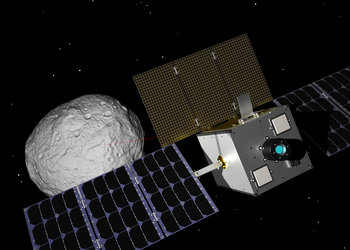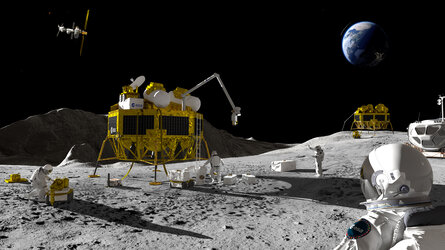Accept all cookies Accept only essential cookies See our Cookie Notice

About ESA
The European Space Agency (ESA) is Europe’s gateway to space. Its mission is to shape the development of Europe’s space capability and ensure that investment in space continues to deliver benefits to the citizens of Europe and the world.
Highlights
ESA - United space in Europe
This is ESA ESA facts Member States & Cooperating States Funding Director General Top management For Member State Delegations European vision European Space Policy ESA & EU Space Councils Responsibility & Sustainability Annual Report Calendar of meetings Corporate newsEstablishments & sites
ESA Headquarters ESA ESTEC ESA ESOC ESA ESRIN ESA EAC ESA ESAC Europe's Spaceport ESA ESEC ESA ECSAT Brussels Office Washington OfficeWorking with ESA
Business with ESA ESA Commercialisation Gateway Law at ESA Careers Cyber resilience at ESA IT at ESA Newsroom Partnerships Merchandising Licence Education Open Space Innovation Platform Integrity and Reporting Administrative Tribunal Health and SafetyMore about ESA
History ESA Historical Archives Exhibitions Publications Art & Culture ESA Merchandise Kids Diversity ESA Brand CentreLatest
Space in Member States
Find out more about space activities in our 23 Member States, and understand how ESA works together with their national agencies, institutions and organisations.
Science & Exploration
Exploring our Solar System and unlocking the secrets of the Universe
Go to topicAstronauts
Missions
Juice Euclid Webb Solar Orbiter BepiColombo Gaia ExoMars Cheops Exoplanet missions More missionsActivities
International Space Station Orion service module Gateway Concordia Caves & Pangaea BenefitsLatest
Space Safety
Protecting life and infrastructure on Earth and in orbit
Go to topicAsteroids
Asteroids and Planetary Defence Asteroid danger explained Flyeye telescope: asteroid detection Hera mission: asteroid deflection Near-Earth Object Coordination CentreSpace junk
About space debris Space debris by the numbers Space Environment Report In space refuelling, refurbishing and removingSafety from space
Clean Space ecodesign Zero Debris Technologies Space for Earth Supporting Sustainable DevelopmentLatest
Applications
Using space to benefit citizens and meet future challenges on Earth
Go to topicObserving the Earth
Observing the Earth Future EO Copernicus Meteorology Space for our climate Satellite missionsCommercialisation
ESA Commercialisation Gateway Open Space Innovation Platform Business Incubation ESA Space SolutionsLatest
Enabling & Support
Making space accessible and developing the technologies for the future
Go to topicBuilding missions
Space Engineering and Technology Test centre Laboratories Concurrent Design Facility Preparing for the future Shaping the Future Discovery and Preparation Advanced Concepts TeamSpace transportation
Space Transportation Ariane Vega Space Rider Future space transportation Boost! Europe's Spaceport Launches from Europe's Spaceport from 2012Latest

RadCube reaches out
Thank you for liking
You have already liked this page, you can only like it once!
ESA’s latest CubeSat – RadCube, for surveying space weather in low-Earth orbit – has completed its rigorous commissioning phase, culminating in the extension of a magnetometer boom longer than the miniature satellite itself.
The surface of Earth is a rare low-radiation oasis, largely protected from the charged particles riddling space by our planet’s magnetic field. RadCube is a mission to demonstrate miniaturised technologies for measuring this space radiation environment as well as magnetic field strength – all within a satellite that could fit into an airliner carry-on bag.
CubeSats are satellites assembled from standardised 10-cm boxes. RadCube is a ‘3-unit’ CubeSat, newly developed for ESA by C3S in Hungary.
Hungary’s Centre for Energy Research (EK) contributed the payload controller system and a radiation telescope to the mission, combining two detectors to measure the direction as well as energy of charged particles. The UK’s Imperial College built a magnetometer consisting of two sensors, one within the CubeSat and another at the end of a rolled-out 80 cm boom, which comes from Astronika in Poland.
Launched aboard ESA’s Vega launcher flight VV19 in August, RadCube also hosts an ESA experiment to test the resilience of computer memories against space radiation.
“The all-new CubeSat platform and the precision of RadCube’s miniature instruments demanded a complex commissioning process, which has now been successfully completed,” explains Dorottya Milánkovich from C3S.
“The full extension of the magnetometer boom marked a dramatic final milestone; this is a necessary feature to prevent any anomalous magnetic measurements emitted from the satellite itself,” says Dominik Nolbert from Astronika.
Jonathan Eastwood from Imperial College adds: “In fact, the outboard magnetometer data clearly shows no magnetic noise coming from RadCube, with results well in line with expected values from Earth magnetic field models.”
“RadCube’s radiation measurements are also showing good comparison data with other satellites, revealing elevated radiation levels from the recent solar storm,” highlights Attila Hirn from EK.
The latest in a series of ESA Technology CubeSats to demonstrate promising technologies for space, RadCube was supported through the ‘Fly’ element of ESA’s General Support Technology Programme, with funding coming from Hungary, the UK and Poland.
-
CREDIT
C3S -
LICENCE
ESA Standard Licence

RadCube boom deployment test

First light from Sunstorm CubeSat

Sunstorm

M–Argo















 Germany
Germany
 Austria
Austria
 Belgium
Belgium
 Denmark
Denmark
 Spain
Spain
 Estonia
Estonia
 Finland
Finland
 France
France
 Greece
Greece
 Hungary
Hungary
 Ireland
Ireland
 Italy
Italy
 Luxembourg
Luxembourg
 Norway
Norway
 The Netherlands
The Netherlands
 Poland
Poland
 Portugal
Portugal
 Czechia
Czechia
 Romania
Romania
 United Kingdom
United Kingdom
 Slovenia
Slovenia
 Sweden
Sweden
 Switzerland
Switzerland

























